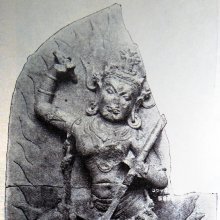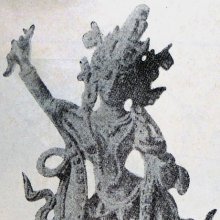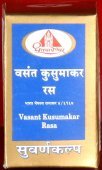Bhasma, Bhasman: 38 definitions
Introduction:
Bhasma means something in Buddhism, Pali, Hinduism, Sanskrit, Jainism, Prakrit, Marathi, Hindi. If you want to know the exact meaning, history, etymology or English translation of this term then check out the descriptions on this page. Add your comment or reference to a book if you want to contribute to this summary article.
Alternative spellings of this word include Bhasm.
Images (photo gallery)
In Hinduism
Ayurveda (science of life)
Rasashastra (Alchemy and Herbo-Mineral preparations)
Source: Academia.edu: Ayurveda and Pharmaceutics (rasashastra)Bhasma (Cinder): Powder of any substance obtained by calcinations is known as bhasma. Metals, minerals and animal products are calcinated in closed crucibles in pits specially made. Example: Abhraka-bhasma.
Toxicology (Study and Treatment of poison)
Source: Shodhganga: Kasyapa Samhita—Text on Visha ChikitsaBhasma (भस्म) refers to “ash” (e.g., gotten from burnt rice), and is used in the treatment of snake-bites such as those caused by the Kṛṣṇamaṇḍalī-snakes, according to the Kāśyapa Saṃhitā: an ancient Sanskrit text from the Pāñcarātra tradition dealing with both Tantra and Viṣacikitsā—an important topic from Āyurveda which deals with the study of Toxicology (Viṣavidyā or Sarpavidyā).—Accordingly, one of the treatments is mentioned as follows: “For the fire-like burning of the wound caused by the bite, a paste or bolus made out of the excreta of pigeon, sap of Kapittha, Viśvābhū and Girikarṇikā must be applied on it with the dry leaves of Aśvamāra. Ash gotten from burnt rice (taṇḍulī-bhasma) must be applied on the body. It can be used for fumigation too”.
Agriculture (Krishi) and Vrikshayurveda (study of Plant life)
Source: Shodhganga: Drumavichitrikarnam—Plant mutagenesis in ancient IndiaBhasman (भस्मन्) refers to “(well-burnt) ashes” which is used in various bio-organical recipes for plant mutagenesis, according to the Vṛkṣāyurveda by Sūrapāla (1000 CE): an encyclopedic work dealing with the study of trees and the principles of ancient Indian agriculture.—Accordingly, “A big and strong mud pot should be filled with the mixture of mud and plenty of beef; and the Nerium indicum plant should be grown there with effort by watering profusely with cow dung and good quality beef. The above stated plant of Nerium indicum should then be shifted to a pit previously prepared by filling with cow bones, well-burnt ashes (sudagdha-bhasman) and then wetted by water mixed with beef. Thereafter, the plant should be fed with plenty of water mixed with beef. So treated, it is transformed into a creeper to blossom profusely and perennially”.
Unclassified Ayurveda definitions
Source: WikiPedia: AyurvedaBhasma (भस्म):—The usual means used to administer these substances is by preparations called bhasma, Sanskrit for "ash".
Source: gurumukhi.ru: Ayurveda glossary of terms1) Bhasma (भस्म):—Ashes of metals / minerals obtained through incineration / calcinations process
2) Ash

Āyurveda (आयुर्वेद, ayurveda) is a branch of Indian science dealing with medicine, herbalism, taxology, anatomy, surgery, alchemy and related topics. Traditional practice of Āyurveda in ancient India dates back to at least the first millenium BC. Literature is commonly written in Sanskrit using various poetic metres.
Purana and Itihasa (epic history)
Source: archive.org: Puranic EncyclopediaBhasma (भस्म).—(Sacred ash). To know a story about the greatness of Bhasma see under the word Durjaya.
Source: archive.org: Shiva Purana - English Translation1) Bhasman (भस्मन्) refers to the “sacred ashes”, symbolically representing the “essence”, as mentioned in the Śivapurāṇa 1.18. Accordingly, “[...] the ash (bhasma) is of three types, derived from ordinary fire, Vedic fire and Śiva fire. The ash derived from ordinary fire shall be used for the purification of articles of mud, wood or metals and even for grains. [...] The ashes resulting from Vedic rites in fire shall be smeared over the forehead at the end of the rites. Since the ashes are purified by the mantras the rite itself takes the form of the ashes. [...] Bilva twigs shall be burnt repeating the Ātma mantra of Aghora. This fire is called Sivāgni. The ashes resulting therefrom are called Śivāgnija”.
For the sake of resplendence, the ashes (bhasma) shall be taken. The word bhasma (Ash) means that which is honoured and adored. Śiva formerly did so.—“A king takes the essence of wealth by way of tax, in his kingdom. Men burn plants and take the essence thereof. The gastirc fire burns different kinds of foodstuffs and with their essence nourishes the body. Similarly the great lord Śiva, the creator of the universe, burns the universe presided over by Him and takes the essence of the same. After burning the universe He applies the ashes (bhasma) over his body”.
According to the Śivapurāṇa 1.24, while explaining the importance of holy ashes (bhasma):—“[...] the ashes (bhasma) of auspicious nature are of two types. I shall explain their characteristics. Please listen attentively. One is known as mahābhasma (Great ashes) and the second is known as svalpa (the little)”.
Also, “A person who has applied ashes (bhasma) on his body actually wears as many liṅgas as there are particles of the ash that remain on his body. [...] Just as the fire when touched with or without knowledge burns the body so does the ash (bhasma) worn consciously or unconsciously sanctify the man”.
2) Bhasman (भस्मन्) or Bhasmamaya refers to “ash”, representing the material of the liṅga of the Yogins, according to the Śivapurāṇa 2.1.12, where the Devas and Viṣṇu requested Viśvakarman for liṅgas for the achievement of the desires of all people:—“[...] at our bidding Viśvakarmā made liṅgas and gave them to the devas according to their status. [...] the Goddesses (Devī) took the liṅgas of butter; the Yogins took liṅgas of the ash (Bhasman-liṅga); the Yakṣas took liṅgas of curd and the deity Chāyā took a liṅga of beaten flour. [...] Thus different kinds of liṅgas were given to them by Viśvakarmā which the devas and the celestial sages worship regularly. After giving the devas the various liṅgas from a desire for their benefit, Viṣṇu explained the mode of worship of Śiva to me, Brahmā”.
Source: Cologne Digital Sanskrit Dictionaries: The Purana IndexBhasma (भस्म).—Sacred ash supposed to be the vīrya of Śiva who is Bhasmasamcchannadeha;1 snānam of, makes one pure: amulet for places of confinement.2
Source: Shodhganga: The saurapurana - a critical studyBhasma (भस्म) represents the “energy of Agni”, according to the 10th century Saurapurāṇa: one of the various Upapurāṇas depicting Śaivism.—Accordingly, the merits of using the bhasma is expressed by the Saurapurāṇa. The bhasma is the energy of Agni and by besmearing bhasma on the body a person becomes powerful (vīryavān) and self-controlled. He becomes liberated from all sins and attains communion with Śiva (śivasāyujya)”.

The Purana (पुराण, purāṇas) refers to Sanskrit literature preserving ancient India’s vast cultural history, including historical legends, religious ceremonies, various arts and sciences. The eighteen mahapuranas total over 400,000 shlokas (metrical couplets) and date to at least several centuries BCE.
Shaivism (Shaiva philosophy)
Source: Wisdom Library: Śaivism1) Bhasman (भस्मन्) refers to one of the five kinds of external marks of an ācārya (“Śaiva preceptor”), according to Nigamajñāna (Śaiva teacher of the 16th century) in his Śaivāgamaparibhāṣāmañjarī.
2) Bhasman (भस्मन्) refers to one of the “eight lords of divisions” (vigraheśvara) associated with the so-called eight divisions (vigraha) according to the Mataṅgapārameśvara (1.8.83–5). These “eight lords of divisions” are also mentioned in a copper-plate inscription found in Malhar, Chhattisgarh, written around 650 CE. The eight divisions (vigraha) represent the uppermost part of the Lākulas’ impure universe.
All these manifestations of Śiva (e.g., Bhasman) appear at the borders of various divisions of the universe according to the Lākula system.
Source: Shodhganga: Iconographical representations of ŚivaBhasma (भस्म) is the name of a deity who received the Yogajāgama from Sudhākhya through the mahānsambandha relation, according to the pratisaṃhitā theory of Āgama origin and relationship (sambandha). The yogaja-āgama, being part of the ten Śivabhedāgamas, refers to one of the twenty-eight Siddhāntāgamas: a classification of the Śaiva division of Śaivāgamas. The Śaivāgamas represent the wisdom that has come down from lord Śiva, received by Pārvatī and accepted by Viṣṇu.
Bhasma obtained the Yogajāgama from Sudhākhya who in turn obtained it from Sadāśiva through parasambandha. Bhasma in turn, transmitted it to Prabhu who then, through divya-sambandha, transmitted it to the Devas who, through divyādivya-sambandha, transmitted it to the Ṛṣis who finally, through adivya-sambandha, revealed the Yogajāgama to human beings (Manuṣya). (also see Anantaśambhu’s commentary on the Siddhāntasārāvali of Trilocanaśivācārya)
Source: Brill: Śaivism and the Tantric TraditionsBhasma (भस्म) refers to “ash”, according to the 9th-century Sarvajñānottaratantra chapter 18.—Accordingly, “Next, I shall teach the best observance among observances, which is known as the Śiva-vrata and which is revered by Asuras and Gods alike. Pure pale ash (bhasma) [should be used, and] white dress and unguents; he should wear a white sacred thread and be adorned by a chignon of matted locks. He should be equipped with all [suitable] ornaments, [and] adorned with white garlands; he should consume [only the pure ritual gruel-offering known as] caru; he should observe the chaste conduct of a student; he should venerate Śiva, the fire and his Guru. [...]”.
Source: SOAS University of London: Protective Rites in the Netra TantraBhasman (भस्मन्) refers to “ash” (used for applying the forehead mark), according to the Netratantra of Kṣemarāja: a Śaiva text from the 9th century in which Śiva (Bhairava) teaches Pārvatī topics such as metaphysics, cosmology, and soteriology.—Accordingly, [verse 19.88-89ab, while describing the ritual that protect the king and his kingdom]—“One should always perform [the recitation of the mantra] for the sake of peace in obligatory rites, special rites, and for fulfillment of special wishes. [The Mantrin should always] apply the forehead mark of white ash (śveta-bhasman) [infused] with seven recitations [of the Amṛteśa] mantra on [the king’s] washed face. [This] removes the pollution caused by the mothers”.

Shaiva (शैव, śaiva) or Shaivism (śaivism) represents a tradition of Hinduism worshiping Shiva as the supreme being. Closely related to Shaktism, Shaiva literature includes a range of scriptures, including Tantras, while the root of this tradition may be traced back to the ancient Vedas.
Nirukta (Sanskrit etymology)
Source: archive.org: Shiva Purana (nirukta)Bhasma (भस्म) means “that which has controlled the essence of the whole universe”. (Bha=vṛddhi (flourishing essence). Sma=svayam. Manyate=‘considers his own’).
Nirukta (निरुक्त) or “etymology” refers to the linguistic analysis of the Sanskrit language. This branch studies the interpretation of common and ancient words and explains them in their proper context. Nirukta is one of the six additional sciences (vedanga) to be studied along with the Vedas.
Shaktism (Shakta philosophy)
Source: Google Books: ManthanabhairavatantramBhasma (भस्म) means “ashes”, according to the second recension of the Yogakhaṇḍa of the Manthānabhairavatantra, a vast sprawling work that belongs to a corpus of Tantric texts concerned with the worship of the goddess Kubjikā.—Accordingly, as the Goddess (i.e., Khageśī) said to the God (i.e., Bhairava), “[...] Being one who has matted hair, shaved head, (having a) topknot, carrying a skull, smeared with ashes [i.e., bhasma-guṇḍita] or wearing the five insignias—O god, (none of this) leads to accomplishment in the Kula tradition. (Even) a renouncer who does not bear the five insignias and is naked does not quickly achieve success in the western (transmission) of the House of the Yoginīs. This is forbidden and (so) all this is absent in the Kaula (teachings). O Maheśvara, as this is improper how can the Command be given to you?”.

Shakta (शाक्त, śākta) or Shaktism (śāktism) represents a tradition of Hinduism where the Goddess (Devi) is revered and worshipped. Shakta literature includes a range of scriptures, including various Agamas and Tantras, although its roots may be traced back to the Vedas.
Jyotisha (astronomy and astrology)
Source: Wisdom Library: Brihat Samhita by VarahamihiraBhasma (भस्म) refers to an “ashy-pale-colored sun”, according to the Bṛhatsaṃhitā (chapter 3), an encyclopedic Sanskrit work written by Varāhamihira mainly focusing on the science of ancient Indian astronomy astronomy (Jyotiṣa).—Accordingly, “If in Varṣā the colour of the sun be that of the flower Śirīṣa (Mimosa flexuosa) there will be immediate rain; if the colour be that of the peacock’s plume there will be no rain for twelve years to come. If, then the sun be black there will be fear from worms and reptiles; if it be ashy pale [i.e., bhasma-nibha] there will be fear from foreign princes; if the sun should appear with a hole that prince will perish in the star of whose nativity the sun then happens to be”.

Jyotisha (ज्योतिष, jyotiṣa or jyotish) refers to ‘astronomy’ or “Vedic astrology” and represents the fifth of the six Vedangas (additional sciences to be studied along with the Vedas). Jyotisha concerns itself with the study and prediction of the movements of celestial bodies, in order to calculate the auspicious time for rituals and ceremonies.
Yoga (school of philosophy)
Source: ORA: Amanaska (king of all yogas): A Critical Edition and Annotated Translation by Jason BirchBhasman (भस्मन्) refers to “ashes”, according to the Amanaska Yoga treatise dealing with meditation, absorption, yogic powers and liberation.—Accordingly, as Īśvara says to Vāmadeva: “[...] Putting on ochre garments, carrying a skull, plucking out clumps of hair, maintaining non-vedic religious observances, ashes (bhasman), ascetic clothing and matted locks, behaving as if mad, [the ascetic practice of] nakedness, [studying] the Vedas, Tantras and so on and the meeting [of learned people] for [reciting] poetry in the assembly: All [this] is exertion for the sake of filling one's stomach and is not the cause of the highest good. [...]”.

Yoga is originally considered a branch of Hindu philosophy (astika), but both ancient and modern Yoga combine the physical, mental and spiritual. Yoga teaches various physical techniques also known as āsanas (postures), used for various purposes (eg., meditation, contemplation, relaxation).
In Buddhism
Tibetan Buddhism (Vajrayana or tantric Buddhism)
Source: archive.org: The Indian Buddhist IconographyBhasma (भस्म) refers to “ashes” and represents one of the five auspicious symbols of Nairātmā.—The Indian Museum image is the only image of this goddess [Nairātmā] which conforms to the description given in the sādhana. Here the goddess, in accordance with the Dhyāna, has a terrible appearance with canine teeth, garland of heads and three eyes rolling in anger. She stands on the corpse lying on its back, and dances in the ardhaparyaṅka attitude. Burning flames radiate from her person, and her hair rise upwards in the shape of a flame. She is decked in the five auspicious symbols, the kaṇṭhikā (torque), rucaka (bracelets), ratna (jewels), mekhalā (girdle), and bhasma (ashes) or the sūtra (sacred thread) in the form of a garland of heads. She bears the image of her sire Akṣobhya on her crown and carries the menacing kartri in the right hand. The left hand holding the kapāla is broken. The khaṭvāṅga, as usual, hangs from her left shoulder.

Tibetan Buddhism includes schools such as Nyingma, Kadampa, Kagyu and Gelug. Their primary canon of literature is divided in two broad categories: The Kangyur, which consists of Buddha’s words, and the Tengyur, which includes commentaries from various sources. Esotericism and tantra techniques (vajrayāna) are collected indepently.
Mahayana (major branch of Buddhism)
Source: Wisdom Library: Maha Prajnaparamita SastraBhasman (भस्मन्) refers to “ash”, according to Mahāprajñāpāramitāśāstra (chapter 31).—Accordingly, “[...] Thrown on the fire (agni), the body becomes ash (bhasman); devoured by insects (kurmi) it becomes dung (purīṣa); placed in the earth, it decays, decomposes, and becomes earth; put into the water, it swells up and decays or it is eaten by water-insects. Of all corpses (kuṇapa), that of man is the most impure: his impurities (aśucidharma) will be explained at length in reference to the nine concepts (navasaṃjñā). [...]”.
Source: De Gruyter: A Buddhist Ritual Manual on AgricultureBhasman (भस्मन्) refers to the “ashes (of oblations)” (suitable for an offering ceremony), according to the Vajratuṇḍasamayakalparāja, an ancient Buddhist ritual manual on agriculture from the 5th-century (or earlier), containing various instructions for the Sangha to provide agriculture-related services to laypeople including rain-making, weather control and crop protection.—Accordingly [as the Bhagavān taught the detailed offering-manual], “Having taken ashes from oblations (āhuti-bhasma), it should be mixed in rice gruel enchanted sixty times with the mantra. It should be thrown into the middle of the [Nāga] residence. Merely upon throwing all Nāgas become agitated. Then they send down rain showers. If it does not rain on the same day, the bodies of all those Nāgas will have spotted leprosy”.

Mahayana (महायान, mahāyāna) is a major branch of Buddhism focusing on the path of a Bodhisattva (spiritual aspirants/ enlightened beings). Extant literature is vast and primarely composed in the Sanskrit language. There are many sūtras of which some of the earliest are the various Prajñāpāramitā sūtras.
In Jainism
General definition (in Jainism)
Source: The University of Sydney: A study of the Twelve ReflectionsBhasman (भस्मन्) refers to “ash”, according to Pūjyapāda’s Sarvārthasiddhi.—Accordingly, “[...] Even if human birth is attained, a good country, a good family, keen senses, health, etc. are more and more difficult of attainment. When all these are attained, if true faith is not acquired, human birth becomes useless like the face without vision. And even after attaining this rare true faith, if anyone is immersed in worldly pleasures, it is like burning sandal-wood paste for the sake of ash (bhasman-artha). [...]”.

Jainism is an Indian religion of Dharma whose doctrine revolves around harmlessness (ahimsa) towards every living being. The two major branches (Digambara and Svetambara) of Jainism stimulate self-control (or, shramana, ‘self-reliance’) and spiritual development through a path of peace for the soul to progess to the ultimate goal.
Languages of India and abroad
Pali-English dictionary
Source: BuddhaSasana: Concise Pali-English Dictionarybhasma : (nt.) ashes.
Source: Sutta: The Pali Text Society's Pali-English DictionaryBhasma, (n) (nt.) (cp. Vedic bhasman (adj.); Sk. bhasman (n.), originally ppr. of bhas to chew & thus n-stem. It has passed into the a-decl. in Pali, except in the Loc. bhasmani (S. I, 169). Etymologically & semantically bhasman is either “chewing” or “anything chewed (small),” thus meaning particle, dust, sand, etc. ; and bhas is another form of psā (cp. Sk. psā morsel of food, psāta hungry=P. chāta). Idg. *bhsā & *bhsam, represented in Gr. yw/xw to grind, yάmmos & yώxos sand; Lat. sabulum sand. The Dhtp 326 & Dhtm 452 explain bhas by bhasmīkaraṇa “reduce to ashes,” a pp. of it is bhasita; it also occurs in Sk. Loc. bhasi) ashes S. I, 169=Nd2 576 (Loc. bhasmani); Vv 8444; J. III, 426; Vism. 469 (in comparison).

Pali is the language of the Tipiṭaka, which is the sacred canon of Theravāda Buddhism and contains much of the Buddha’s speech. Closeley related to Sanskrit, both languages are used interchangeably between religions.
Marathi-English dictionary
Source: DDSA: The Molesworth Marathi and English Dictionarybhasma (भस्म).—n (S) Ashes. 2 Any metallic oxyde.
Source: DDSA: The Aryabhusan school dictionary, Marathi-Englishbhasma (भस्म).—n Ashes. Any metallic oxide.
Marathi is an Indo-European language having over 70 million native speakers people in (predominantly) Maharashtra India. Marathi, like many other Indo-Aryan languages, evolved from early forms of Prakrit, which itself is a subset of Sanskrit, one of the most ancient languages of the world.
Sanskrit dictionary
Source: DDSA: The practical Sanskrit-English dictionaryBhasman (भस्मन्).—n. [bhas-manin]
1) Ashes; (kalpate) ध्रुवं चिताभस्मरजो विशुद्धये (dhruvaṃ citābhasmarajo viśuddhaye) Kumārasambhava 5.79.
2) Sacred ashes (smeared on the body); महादेवोऽथ तद्भस्म मनोभवशरीरजम् । आदाय सर्व- गात्रेषु भूतिलेपं तदाकरोत् (mahādevo'tha tadbhasma manobhavaśarīrajam | ādāya sarva- gātreṣu bhūtilepaṃ tadākarot) || Kālikā P. (bhasmani hu 'to sacrifice in ashes', i. e. to do a useless work).
Source: Cologne Digital Sanskrit Dictionaries: Shabda-Sagara Sanskrit-English Dictionary
Bhasman (भस्मन्).—n. (-sma) 1. Ashes. 2. Holy ashes. E. bhas to shine, Unadi aff. manin .
Source: Cologne Digital Sanskrit Dictionaries: Benfey Sanskrit-English DictionaryBhasman (भस्मन्).— (cf. bhasita), n. Ashes, [Hitopadeśa] ii. [distich] 163.
Source: Cologne Digital Sanskrit Dictionaries: Cappeller Sanskrit-English DictionaryBhasman (भस्मन्).—[adjective] chewing, devouring. [neuter] (also [plural]) ashes, [ablative] bhasmatas.
Source: Cologne Digital Sanskrit Dictionaries: Monier-Williams Sanskrit-English DictionaryBhasma (भस्म):—[from bhas] in [compound] for bhasman.
Source: Cologne Digital Sanskrit Dictionaries: Monier-Williams Sanskrit-English Dictionary1) Bhasman (भस्मन्):—[from bhas] a mfn. chewing, devouring, consuming, pulverizing, [Ṛg-veda v, 19, 5; x, 115, 2]
2) [v.s. ...] n. (also [plural]) ‘what is pulverized a or calcined by fire’, ashes, [Atharva-veda] etc. etc. (yuṣmābhir bhasma bhakṣayitavyam, ‘you shall have ashes to eat’ id est. ‘you shall get nothing’ [Hitopadeśa]; mani-huta. mfn. ‘sacrificed in a°’ id est. ‘useless’ [Pāṇini 2-1, 47 [Scholiast or Commentator]])
3) [v.s. ...] n. sacred ashes (smeared on the body; cf. bhasma-dhāraṇa).
4) b etc. See above.
Source: Cologne Digital Sanskrit Dictionaries: Yates Sanskrit-English DictionaryBhasman (भस्मन्):—(sma) 5. m. Ashes.
Source: DDSA: Paia-sadda-mahannavo; a comprehensive Prakrit Hindi dictionary (S)Bhasman (भस्मन्) in the Sanskrit language is related to the Prakrit words: Bhasama, Bhassa, Bhāsa.
[Sanskrit to German]
Sanskrit, also spelled संस्कृतम् (saṃskṛtam), is an ancient language of India commonly seen as the grandmother of the Indo-European language family (even English!). Closely allied with Prakrit and Pali, Sanskrit is more exhaustive in both grammar and terms and has the most extensive collection of literature in the world, greatly surpassing its sister-languages Greek and Latin.
Hindi dictionary
Source: DDSA: A practical Hindi-English dictionaryBhasma (भस्म) [Also spelled bhasm]:—(nf) ash, cinders, calx; ~[sāt] reduced to ashes, burnt to ashes;—[caḍhānā/ramānā/lagānā] to turn into an ascetic/a mendicant; —[honā] to be reduced to ashes; to be ruined.
...
Kannada-English dictionary
Source: Alar: Kannada-English corpusBhasma (ಭಸ್ಮ):—
1) [noun] the powdery residue of matter that remains after burning; ash.
2) [noun] the ash of the burnt cowdung cake, regarded as holy.
Kannada is a Dravidian language (as opposed to the Indo-European language family) mainly spoken in the southwestern region of India.
See also (Relevant definitions)
Starts with (+107): Bhashmamusha, Bhasmabana, Bhasmabha, Bhasmabhadrikadi, Bhasmabhasvara, Bhasmabhava, Bhasmabhushita, Bhasmabhuta, Bhasmacala, Bhasmacaya, Bhasmacchanna, Bhasmachaya, Bhasmadharana, Bhasmadharanavidhi, Bhasmadhari, Bhasmadharitva, Bhasmadhulita, Bhasmadigdha, Bhasmadilakshana, Bhasmagandha.
Ends with (+13): Abhrakabhasma, Ahutibhasman, Anukalpabhasma, Citabhasma, Citibhasma, Dagdhabhasman, Dhatubhasma, Haratalabhasma, Jatabhasman, Kamabhasman, Lauhabhasma, Lohabhasma, Muga-bhasma, Muktabhasma, Nagabhasma, Pandarabhasma, Rasabhasma, Satvabhasma, Shamkhabhasma, Shivabhasma.
Full-text (+256): Bhasmavedhaka, Bhasmakara, Bhasmagarbha, Bhasmatula, Rasabhasman, Bhasmameha, Bhasmahvaya, Homabhasman, Bhasmasat, Bhasmasharkara, Bhasmayanya, Bhasmagandhika, Bhasmacala, Bhasmalepana, Bhasmaroga, Bhasmavidhi, Bhasmi, Bhasmana, Rasabhasmavidhi, Sabhasmadvija.
Relevant text
Search found 36 books and stories containing Bhasma, Bhasman; (plurals include: Bhasmas, Bhasmans). You can also click to the full overview containing English textual excerpts. Below are direct links for the most relevant articles:
Shaiva Upanishads (A Critical Study) (by Arpita Chakraborty)
8b. Different names of Bhasma < [Chapter 2 - Greatness of Bhasma and Dhāraṇa]
3. Mantra and Application of Bhasma < [Chapter 2 - Greatness of Bhasma and Dhāraṇa]
17. Bhasmasnāna to acquire Knowledge < [Chapter 2 - Greatness of Bhasma and Dhāraṇa]
The Devi Bhagavata Purana (by Swami Vijñanananda)
Chapter 13 - On the greatness of Bhasma < [Book 11]
Chapter 15 - On the rules of using the Tripuṇḍra and Ūrdhapuṇḍra marks < [Book 11]
Chapter 14 - On the greatness in holding the Bibhūti < [Book 11]
The Linga Purana (by J. L. Shastri)
Chapter 18 - The holy Pāśupata rite < [Section 2 - Pūrvabhāga]
Chapter 108 - Glory of the Pāśupata-Vrata < [Section 1 - Uttarabhāga]
Chapter 33 - The mode of gifting the kalpa tree < [Section 2 - Pūrvabhāga]
The Brahmanda Purana (by G.V. Tagare)
Chapter 27 - Śiva cursed by Dāruvana sages: their repentance and prayer < [Section 2 - Anuṣaṅga-pāda]
Chapter 1 - Birth of seven sages (saptarṣi): Race of Bhṛgu and Aṅgiras < [Section 3 - Upodghāta-pāda]
Chapter 26 - The Origin of the Liṅga-Image of Śiva < [Section 2 - Anuṣaṅga-pāda]
The Skanda Purana (by G. V. Tagare)
Chapter 14 - Brahmā’s Redemption from Śiva’s Curse < [Section 1 - Setu-māhātmya]
Chapter 16 - Efficacy of the Holy Ash (Continued) < [Section 3 - Brāhmottara-khaṇḍa]
Chapter 15 - Efficacy of the Holy Ash < [Section 3 - Brāhmottara-khaṇḍa]
Vakyapadiya of Bhartrihari (by K. A. Subramania Iyer)
Verse 3.7.50 < [Book 3 - Pada-kāṇḍa (7): Sādhana-samuddeśa (On the Means)]
Related products
(+176 more products available)







